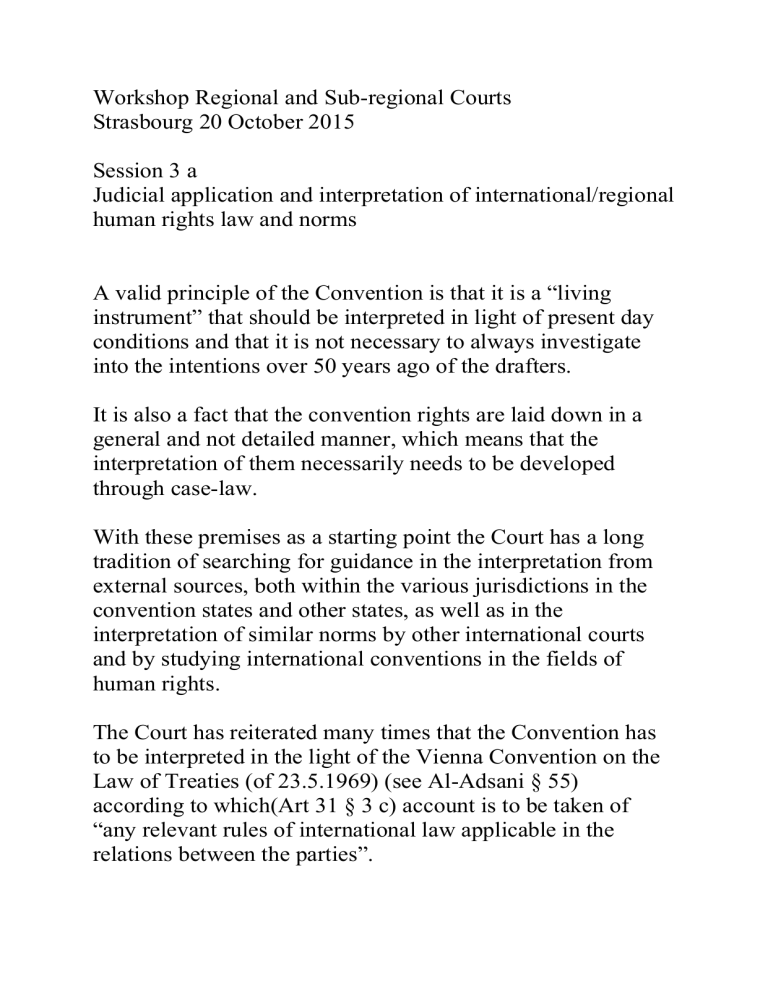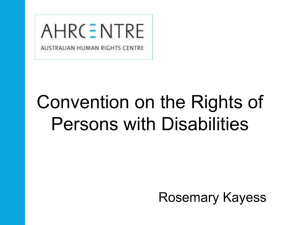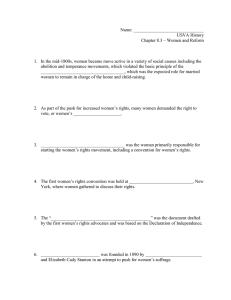Workshop Regional and Sub-regional Courts Strasbourg 20 October 2015 Session 3 a

Workshop Regional and Sub-regional Courts
Strasbourg 20 October 2015
Session 3 a
Judicial application and interpretation of international/regional human rights law and norms
A valid principle of the Convention is that it is a “living instrument” that should be interpreted in light of present day conditions and that it is not necessary to always investigate into the intentions over 50 years ago of the drafters.
It is also a fact that the convention rights are laid down in a general and not detailed manner, which means that the interpretation of them necessarily needs to be developed through case-law.
With these premises as a starting point the Court has a long tradition of searching for guidance in the interpretation from external sources, both within the various jurisdictions in the convention states and other states, as well as in the interpretation of similar norms by other international courts and by studying international conventions in the fields of human rights.
The Court has reiterated many times that the Convention has to be interpreted in the light of the Vienna Convention on the
Law of Treaties (of 23.5.1969) (see Al-Adsani § 55) according to which(Art 31 § 3 c) account is to be taken of
“any relevant rules of international law applicable in the relations between the parties”.
One may distinguish between on the one hand cases where
Court has had to take a stand on complaints that relate directly to the interpretation of an international treaty, such as the
Hague Convention (25.10.1980) on the civil aspects of international child abduction, ex X v. Latvia (GC
26.11.2013), which concerned complaints under Article 8 - family life.
On the other hand, and much more common, are the cases where it has been deemed necessary to look at international instruments and recommendations as an aid in interpreting a convention right.
Examples can be found in expulsion cases where the complaint relates to Article 3 inhuman treatment: Sufi and
Elmi v UK where the Court had to determine the risk of illtreatment in Somalia after expulsion from UK (not GC
28.6.2011). The Court considered UK domestic case law, and
Swedish, and various states’ official reports on the situation in
Somalia, UN reports and reports by NGOs. The Court reassessed the risk in Somalia in a subsequent judgment
K.A.B v Sweden (5.9.2023) with reference to fresh state and
UNHCR reports.
Some other examples:
Ne bis in idem
Margus v Croatia GC 27 May 2014
Article 4 of Protocol no 7 Right not to be punished twice
Applicant complained to the court after having been convicted of war crimes by the Croatian courts. The problem was that he had previously been granted
amnesty in Croatia for the same crimes.
The Court cited a number of international instruments in order to settle the case such as the Vienna convention on the law of treaties, the Geneva convention for the protection of victims of armed conflicts, the convention on the prevention and punishment of the crime of genocide, the convention on the non-applicability of statutory limitations to war crimes and crimes against humanity, the statute of the International Criminal Court, customary rules of international humanitarian law, a UN security council resolution on the situation in Croatia, the covenant on civil and political rights, comments by the
UN Human Rights Committee, the Convention against torture, resolutions by the UN Commission on Human
Rights, a European Parliament resolution on human rights in the world, a report by the UN special rapporteur on Torture.
Furthermore judgments by the ICTY and the Inter-
American Court of Human rights, as well as the
Extraordinary chambers in the Courts of Cambodia and the Special Court for Sierra Leone were referred to.
The applicant’s complaint was declared inadmissible as the court found that the right not to be punished twice was not applicable when the Croatian authorities had acted in compliance with Articles 2 and 3 of the convention and in compliance with international mechanisms and instruments in charging and convicting the applicant for serious crimes against humanity.
Procedural limb of Article 2; the state’s responsibility to investigate effective investigation into circumstances of death.
Hassan v UK (GC 16.9.2014)
The applicant’s relative had been found dead after having been released from detention in in a prison camp Iraq and directed a complaint against UK, whose agents had taken the applicant’s relative into detention.
Here also various international instruments were referred to and the case-law of ICJ and domestic case-law in UK
A very recent judgment, Perincek v Switzerland (GC
15.10.2015) deals with article 10, freedom of expression, in a situation where the applicant denied that the
Armenians had been the victims of a genocide.
The Court doesn’t take a stand on the issue of whether there had been a genocide or not. However, it made extensive references to international law in order to assess i a whether there existed an international obligation to punish genocide deniers: The Convention on the prevention and punishment of the crime of genocide, judgments of the Rwanda tribunal, ICJ in relation to Serbia and Montenegro, The International
Convention on the elimination of all forma of racial discrimination (CERD), The international Covenant on civil and political rights. Plus CoE materials: Convention on cybercrime (additional protocol), a recommendation by the CoM on “hate speech”, reports of the ECRI
(European commission against racism and intolerance).
Plus EU law and domestic law in Convention states.
---
These are just some examples of readiness of the Court to take into account various aspects of international and comparative law.





